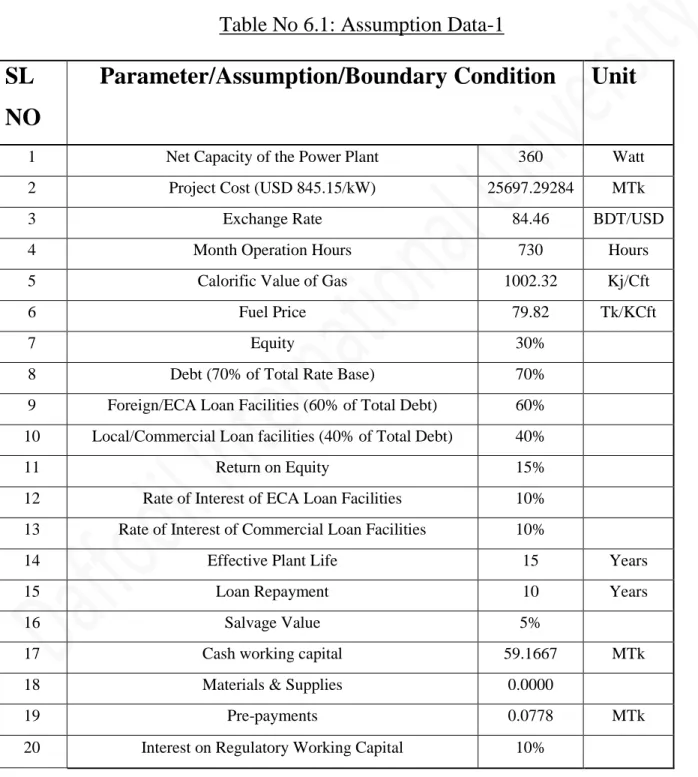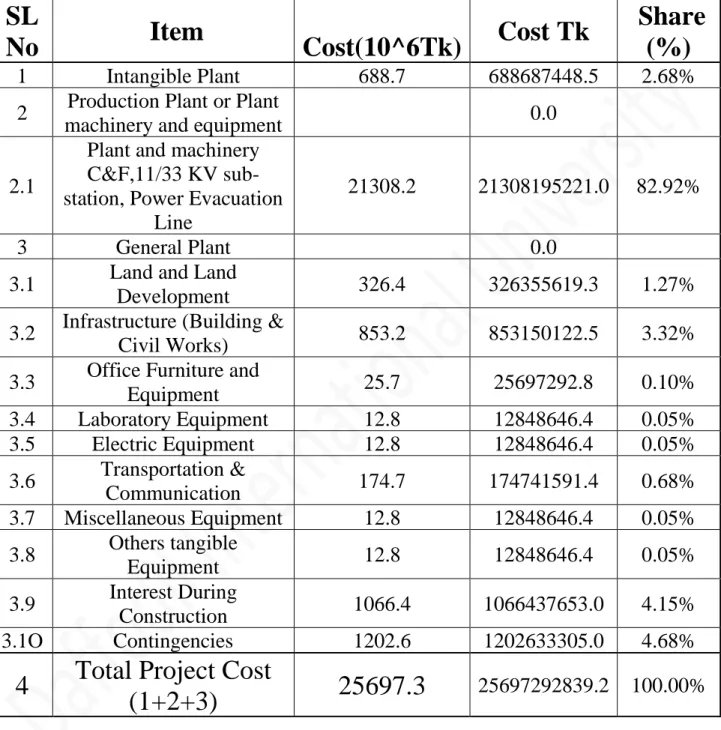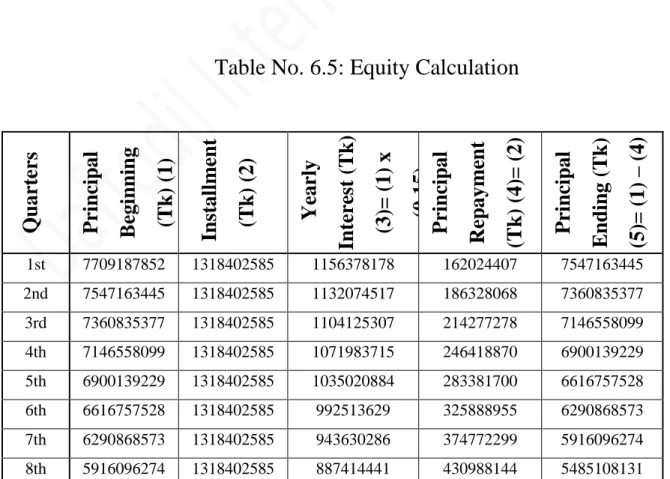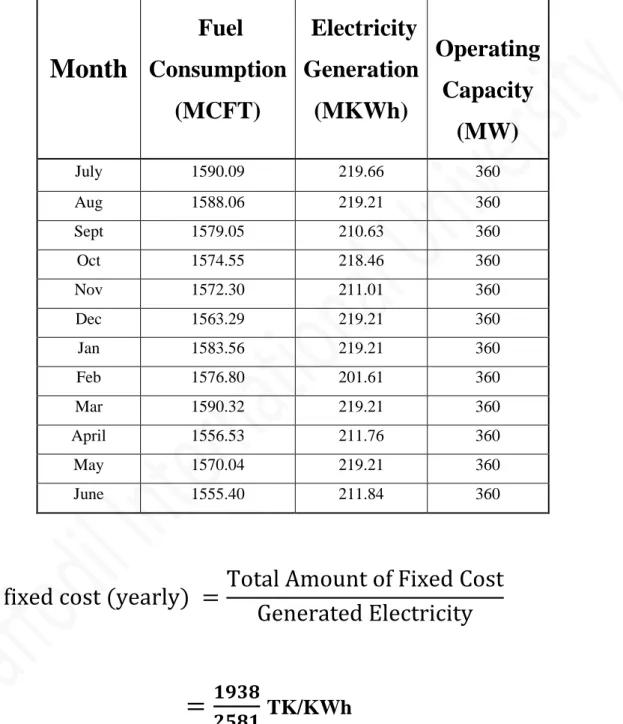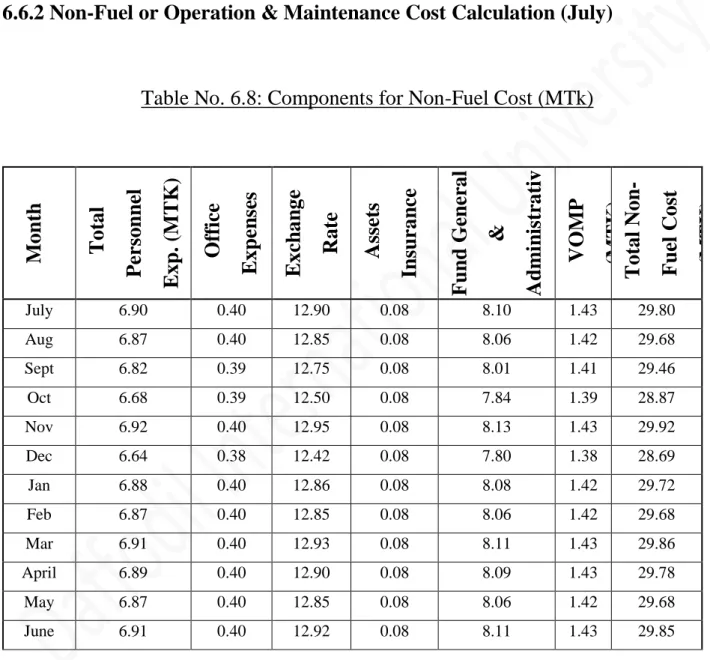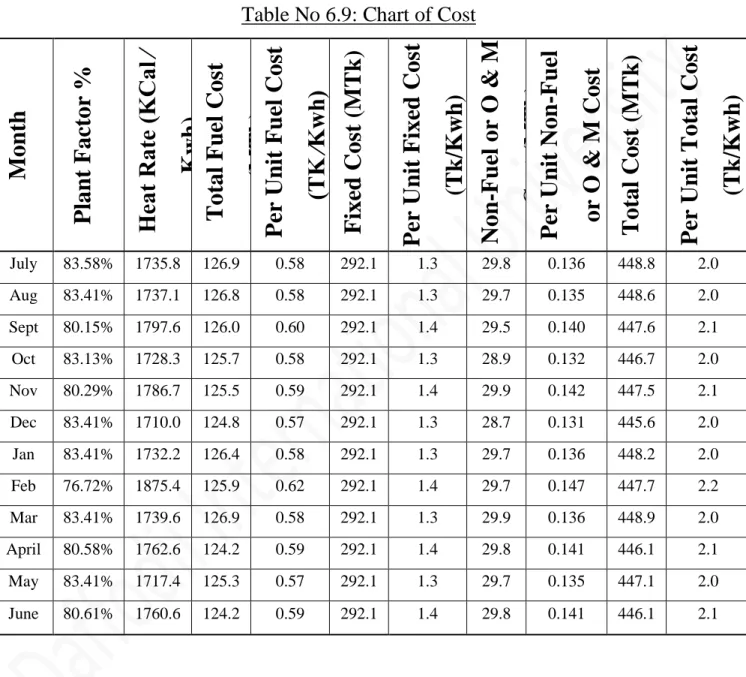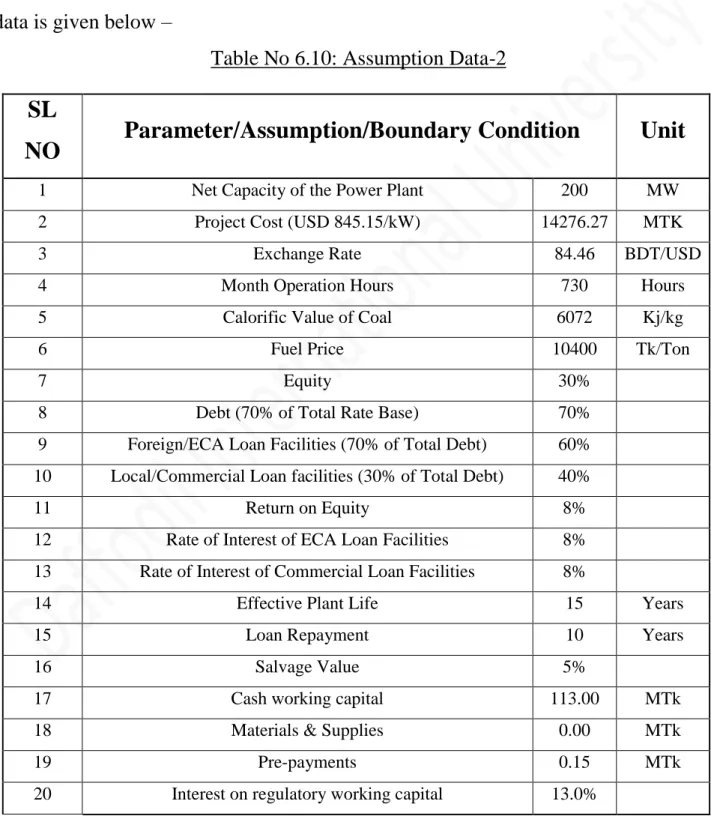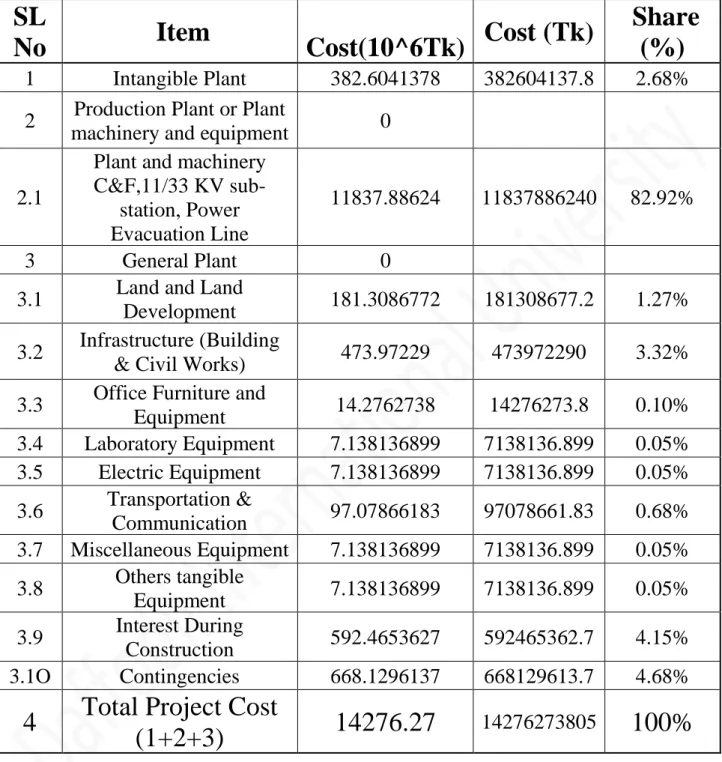DAFFODIL INTERNATIONAL UNIVERSITY
THESIS PAPER
ON
“STUSY ON ELECTRICITY GENERATION COST DETERMINATION”
Supervisor
Dr. M. Shamsul Alam Professor and Dean Faculty of Engineering Daffodil International University
Prepared By
Abdur Rahman ID: 153-33-2911 Department of EEE
Daffodil International University
©DAFFODIL INTERNATIONAL UNIVERSITY ii APPROVAL
This thesis titled “Study on Electricity Generation Cost Determination”, submitted by Abdur Rahman to the Department of Electrical and Electronics Engineering, Daffodil International University, has been accepted as satisfactory for the partial fulfillment of the requirements for the degree of B.Sc. Electrical and Electronics Engineering and approved as to its style and contents. The presentation has been held on
BOARD OF EXAMINERS
_______________________
Professor Dr. M. Shamsul Alam Dean
Faculty of Engineering
©DAFFODIL INTERNATIONAL UNIVERSITY iii
DECLARATION
We hereby declare that; this thesis has been done by us under the supervision of Dr. M.
Shamsul Alam Professor Dean Faculty of Engineering Daffodil International University. We also declare that neither this thesis nor any part of this thesis has been submitted elsewhere for award of any degree or diploma.
Supervised by:
Professor Dr. M. Shamsul Alam Dean
Faculty of Engineering
Daffodil International University
Submitted by:
Abdur Rahman ID: 153-33-2911 Department of EEE
Daffodil International University
©DAFFODIL INTERNATIONAL UNIVERSITY iv ACKNOWLEDGEMENT
First, we express our heartiest thanks and gratefulness to almighty Allah for his Divine blessing makes us possible to complete this thesis successfully.
We feel grateful to and wish our profound our indebtedness to Professor Dr. M.
Shamsul Alam Dean Faculty of Engineering Daffodil International University, Dhaka. Deep knowledge& keen interest of our supervisor in the field of Electric power influenced us to carry out this thesis. His endless patience, scholarly guidance, continual encouragement, constantan energetic supervision, constructive criticism, valuable advice at all stage made it possible to complete this thesis. We would like to thank our entire course mate in Daffodil International University, who took part in this discuss while completing the course work.
Finally, we must acknowledge with due respect the constant support and patients
of our parents.
©DAFFODIL INTERNATIONAL UNIVERSITY v ABSTRACT
This thesis is on “Study on Electricity Generation Cost Determination”. In the solicited bids, the bidders shall offer bulk power tariff based on the capacity payment and energy payment and also provide the equivalent levelized tariff. The capacity payment will be made in Bangladeshi currency (Taka). This will cover debt service, return on equity, fixed operation and maintenance cost, insurance and other fixed cost. The energy payment will be denominated in local currency to the extent to which the variable costs are in local currency. This will cover the variable costs of operation and maintenance, including fuel. Interconnection of IPP to transmission system: The power will be purchased from the IPP at a specified voltage and frequency at the outgoing terminal of the substation of the power plant.
The cost of interconnecting facilities up to outgoing terminals of the private power
project will be borne by the private power producers. Severe power crisis
compelled the Government to enter into contractual agreements for high cost
temporary solution, such as rental power and small IPPs, on an emergency basis,
much of its diesel or liquid-fuel based. This has imposed tremendous fiscal
pressure. With a power sector which is almost dependent on natural-gas fired
generation (89.22%), the country is confronting a simultaneous shortage of natural
gas and electricity. Nearly 400-800 MW of power could not be availed from the
power plants due to shortage of gas supply. Other fuels for generating low-cost,
base-load energy, such as coal, or renewable source like hydropower, are not
readily available and Government has no option but to go for fuel diversity option
for power generation.
©DAFFODIL INTERNATIONAL UNIVERSITY vi TABLE OF CONTENTS
TABLE OF CONTENTS
INDEX Page
No
Board of examiners ii
Declaration iii
Acknowledgement iv
Abstract v
CHAPTERS
CHAPTER 1: INTRODUCTION
1.1: Introduction 9
1.2: Electricity Generation Structure 10
1.3: Use of different types of energy 11
1.4: Power Sector in Outline Perspective Plan of Bangladesh 12
1.5: Objectives 14
1.6: Thesis Outlines 14
CHAPTER 2: ELECTRICITY GENERATION TARIFF
2.1: Tariff 15
2.2: Electricity tariff 15
2.3: Basis of electricity rates 15
2.4: Electricity generation 16
2.5: Electricity generation in Bangladesh 16
2.6: Important terms for Calculation 16
2.7: Electricity Situation at a glance 19
CHAPTER 3: PROJECT COST
3.1: Used and Useful Assets 21
3.2: Intangible Plant 21
3.3: Production Plant 22
3.4: General Plant 22
CHAPTER 4: FIXED COST
4.1: Depreciation 23
4.2: Loan 23
4.3: Export Credit Agency (ECA) Loan 24
4.4: Commercial Loan 24
4.5: Equity 25
4.6: Return on Equity 25
4.7: Regulatory Working Capital (RWC) 26
4.8: Cash Working Capital 27
4.9: Materials & Supplies Inventory 27
4.10: Pre-payments 28
©DAFFODIL INTERNATIONAL UNIVERSITY vii
CHAPTER 5: VARIABLE COST
5.1: Fuel Cost 29
5.2: Important Terms for Calculation
29
5.3: Non-Fuel or Operation & Maintenance Cost 30
CHAPTER 6: TARIFF CALCULATION
6.1: Tariff Calculation Method 32
6.2: Assumption Data-1 33
6.3: Project Cost 34
6.4: Fixed Cost Calculation 35
6.4.1: Depreciation Calculation 35
6.4.2: ECA loan calculation 35
6.4.3: Commercial loan calculation 38
6.4.4: Equity calculation 41
6.5: Total fixed cost and per unit fixed cost 43
6.6: Variable cost calculation 44
6.6.1: Fuel Cost Calculation 45
6.6.2: Non-Fuel or Operation and Maintenance cost Calculation (July) 46
6.7: Chart of cost 47
6.8: Assumption Data-2 48
6.9: Project Cost 49
6.10: Fixed Cost Calculation 49
6.10.1: Depreciation Calculation 49
6.10.2: ECA loan calculation 50
6.10.3: Commercial loan calculation 53
6.10.4: Equity calculation 55
6.11: Total fixed cost and per unit fixed cost 57
6.12: Variable cost calculation 58
6.12.1: Fuel Cost Calculation 58
6.12.2: Non-Fuel or Operation and Maintenance cost Calculation (July) 59
6.13: Chart of cost 60
6.14: Assumption Data-3 61
6.15: Project Cost 62
6.16: Fixed Cost Calculation 63
6.16.1: Depreciation Calculation 63
6.16.2: ECA loan calculation 63
6.16.3: Commercial loan calculation 65
6.16.4: Equity calculation 68
6.17: Total fixed cost and per unit fixed cost 69
6.18: Variable cost calculation 70
6.18.1: Fuel Cost Calculation 70
6.18.2: Non-Fuel or Operation and Maintenance cost Calculation (July) 71
6.19: Chart of cost 72
6.20: Tariff Rate 73
6.21: Bill Explanation 74
CHAPTER 7: CONCLUSION
7.1: Conclusion 76
viii
©DAFFODIL INTERNATIONAL UNIVERSITY
7.2 Limitations of the Work 77
7.3: Future Scopes of the Work 78
7.4: REFERENCES 79
CHART OF TABLES
Table No. 2.1 19
Table No. 6.1: Assumption data-1 33
Table No. 6.2: Project Cost 34
Table No. 6.3: ECA loan calculation 37
Table No. 6.4: Commercial loan calculation 40
Table No. 6.5: Equity calculation 42
Table No. 6.6: Total Fixed Cost 43
Table No. 6.7: Power Production Statement 44
Table No. 6.8: Components for Non-Fuel Cost (MTk) 46
Table No. 6.9: Chart of cost 47
Table No. 6.10: Assumption Data-2 48
Table No. 6.11: Project cost 49
Table No. 6.12: ECA Loan Calculation 51
Table No. 6.13: Commercial loan calculation 54
Table No. 6.14: Equity calculation 56
Table No. 6.15: Total Fixed cost 57
Table No. 6.16: Power Production Statement 57
Table No. 6.17: Components for Non-Fuel Cost (MTk) 59
Table No. 6.18: Chart of Cost 60
Table No. 6.19: Assumption Data 3 61
Table No. 6.20: Project cost 62
Table No. 6.21: ECA Loan Calculation 64
Table No. 6.22: Commercial loan calculation 67
Table No. 6.23: Equity calculation 69
Table No. 6.24: Fixed cost 69
Table No. 6.25: Power Production Statement 70
Table No. 6.26: Components for Non-fuel cost (MTk) 71
Table No. 6.27: Chart of cost 72
Table No. 6.28: Tariff Rate 73
©DAFFODIL INTERNATIONAL UNIVERSITY 9
CHAPTER 1
INTRODUCTION
1.1 Introduction
Electricity is the key of all modern inventions. Now-a-days it is a basic need of our everyday life.
It plays a great role wherever people live and works in industry, agriculture, and transportation etc.
The living customary and prosperity of a nation vary directly with increase in use of power. As technology is advancing the consumption of power is steady rising. Sufficient and reliable supply of electricity may be a major requirement for a sustained and triple-crown economic development effort and economic condition reduction. In Bangladesh 149.4 million of the populations out of 167 million don't have direct access to electricity and remaining 17.6 million folks have access however reliable and quality power remains on the far side their reach (BPDB, 2018). So as to realize the expansion rate, handiness of a fairly priced and reliable supply of electricity may be a requirement. Gift generation of electrical power in Bangladesh isn't sufficient to satisfy the customers growing demand. Therefore, it's uphill to make sure a relentless provides of electrical power to all or any customers throughout the country. On the opposite hand, the present power stations have lost their lifetime; they're not reliable for steady generation. Therefore, it's to get replaced previous generating units in varied power stations. Shortage of power is significant issue and robust barrier for the event of our country. Government of Bangladesh has such a large amount of limitations to line up sufficient powerhouse. The GOVT has given high priority to development of the arena considering its importance in overall development of the country. The GOVT has set the goal of providing electricity to all or any voters by 2020. [1] And to achieve this goal the government has already taken many steps. A lot of new power plants has been established.
Bangladesh's energy infrastructure is kind of tiny, inadequate and poorly managed. The per capita energy consumption in Bangladesh is one amongst very cheap (433 kWh) within the world. Non- commercial energy sources, equivalent to wood fuel, animal waste and crop residues square measure calculable to account for over 1/2 the country's energy consumption. Bangladesh has tiny reserves of oil and coal however terribly massive fossil fuel resources. Industrial energy consumption is usually fossil fuel (around 66%), followed by oil, hydropower and coal. Electricity is that the major supply of power for many of the country's economic activities. Bangladesh's put in electrical generation capability is 20000 MW in 2018 [2]; 90 percent of that is taken into account to be
‘available’. 90 percent of the population has access to electricity with a per capita handiness of 433
©DAFFODIL INTERNATIONAL UNIVERSITY 10
kWh every year. (29 0ctober, 2017)
Problems within the Bangladesh’s electrical power sector embody corruption in administration, high system losses, and delays in completion of recent plants, low efficiencies, erratic power offer, electricity felony, blackouts and shortages of funds for power station maintenance. Overall, the country’s generation plants are unable to satisfy system demand over the past decade. [3]
1.2 Electricity Generation Structure
Under the Ministry of Power, Energy & Mineral Resources and Bangladesh Energy Regulatory Commission (BERC), government companies generate electricity with many different types of Power Plants. On the other hand, through IPP (Independent Power Producer) and through Rental electricity is produced in the private sector which is purchased by the Government at a fixed rate.
Besides that, big industries produce 1200 MW electricity for their ow use from which additional 88 MW is supplied to the national grid. At present nearly, 63 percent of total electricity production is produced from public entities. BPDB alone produces 46 percent of total electricity production.
Electricity Generation Structure can be shown as:
Ministry of Power, Energy & Mineral Resources
Energy & Mineral
Resources Division BERC Division Power
Power Cell CEI REB
Rural Power Co. Ltd
PBS
DPDC DESCO BPDB
PGCB
APSCL
EGCB
NWPGCL
WZPDCL
IIPs
©DAFFODIL INTERNATIONAL UNIVERSITY 11 1.3 Use of Different Types of Energy
Natural Gas is used as primary energy in most of the present power plants. 58.45% of total electricity is made from gas-based power plants. Besides gas, 9.69% of electricity is made by burning High Speed Diesel (HSD), 20.69% is made by burning Furnace Oil, 3.02% is made by burning coal, 0.13%
comes from renewable energy and 6.69% is imported from India. Additionally, virtually the 1.33%
of total electricity is made from Karnafuly Hydro power station. Because of the rise of multiple use of gas in chemical, industries, factories and alternative sectors it's unfeasible to produce adequate amount gas (extracted from the present gas fields) to fulfill the demand of the facility plants.
Insufficiency of gas causes 500MW less production of electricity from existing power plants.
From the above discussion it is evident that in the power sector the following issues are to be addressed with due importance at the moment -
➢ Inadequacy of supply of electricity compared to demand.
➢ Dependency on single energy (gas) for electricity generation.
➢ Investment or participation of private sector in electricity generation is at the minimum level.
➢ To meet the increasing demand of electricity huge amount of investment is
needed, the lion's share of which should come from private sector or from public- private partnership.
➢ Shortage of electricity is not attributed to generation alone but transmission and distribution are also responsible for the existing short fall.
©DAFFODIL INTERNATIONAL UNIVERSITY 12
➢ Limited use of renewable energy.
The Perspective arrange of the GOVT and also the Work arrange framed in per the angle arrange towards mitigation of the on top of mentioned issues square measure mentioned within the following chapters.
1.4 Power Sector in Outline Perspective Plan of Bangladesh
Following Vision for Power Sector Development has been mentioned in the Outline Perspective Plan of Bangladesh (2010-2021) –
➢ Electricity Generation in the country by 2010: 6500 MW
➢ Electricity Generation in the country by 2013: 8500 MW
➢ Electricity Generation in the country by 2015: 11,500 MW
➢ Electricity Generation in the country by 2018: 14000 MW
➢ Electricity Generation in the country by 2021: 20,000 MW
➢ Electricity for all by 2021
There is a planning of the Government of achieving the following objectives for making the vision a reality. The Following issues have been identified to reach the objectives –
➢ To ensure energy security.
➢ Making the power sector financially viable and able to facilitate economic growth.
➢ Increasing the sector’s efficiency.
➢ Introducing a new corporate culture in the power sector entities.
➢ Improving the reliability and quality of electricity supply.
➢ Using natural gas including imported Liquefied Natural Gas (LNG), coal and oil as the primary fuels for electricity generation.
➢ Increasing private sector participation to mobilize finance.
➢ Matching supply and demand for electricity.
©DAFFODIL INTERNATIONAL UNIVERSITY 13
➢ To ensure energy security for all.
➢ To reduce the consumption of natural gas, thereby releasing gas for use as
fertilizer, or to increase the use of coal for electricity production to release gas for alternative use.
➢ Finalization of the coal extraction plan.
➢ Reasonable cost-effective price policy for gas, coal and electricity, these being under government control.
➢ Energy mix for electricity generation.
➢ Energy conservation.
➢ Promotion of renewable.
➢ Efficiency of the power sector.
➢ Reduction of system loss.
➢ Importation of LNG.
To address these issues the following Constraints, Possibilities & Strategies are identified –
1.4.1 Constraints
➢ Insufficiency of fuel.
➢ Absence of adequate public and private investment in power generation.
➢ Absence of Cost Reflective Tariffs.
➢ Absence of Primary Energy Supply Chain.
1.4.2 Possibilities
➢ Coal-based power plants using domestic and imported coal.
➢ Rup-pur Nuclear Power Plant.
➢ Availability of new gas both Off-shore and On-shore.
➢ Public-Private Partnership Projects.
➢ Prospect of participation of local investors in the sector.
➢ Medium-term agreement to import LNG and steps to be taken.
©DAFFODIL INTERNATIONAL UNIVERSITY 14 1.4.3 Strategies
➢ To diversify the use of primary energy, such as - gas, coal and liquid fuel, for power generation.
➢ To have provision for dual fuel in power plants wherever possible.
➢ To increase power generation through renewable sources, such as solar, wind, small hydro etc.
➢ To implement nuclear fuel-based power plant.
➢ To finance power generation projects through Public-Private Partnership, government funding for Independent Power Producer (IPP).
➢ To increase sector efficiency, reform measures must be implemented. [4]
1.5 Objective
The Objective of this thesis study is to calculate the generating price of an electrical power station that’s tariff calculation. The most objective is to be told concerning tariff and the way to calculate generating price of an electrical station. This thesis can facilitate to seek out the parameters that square measure caused to maximize the generating price. To do this, following terms need to be calculated one in every of them is that the fastened prices of generation, like Depreciation Expenses, Loan, Equity & regulative assets (RWC) and another one is Variable Costs that embody Fuel price and Non-Fuel price. Adding these 2 prices (Fixed Cost & Variable Costs) can result in the full generating price. Then it’ll be simple to seek out the parameters that have an effect on the generating price largely and to reduce the generating price by taking necessary steps.
1.6 Thesis Outline
This thesis study is organized as follows –
Chapter-1 introduces the electricity generation structure, use of different types of energy,
power sector in outline perspective plan of Bangladesh and the objective of this thesis study.
Chapter-2 reviews the electricity generation tariff and electricity generation in Bangladesh.
Chapter-3 discusses about the project cost of power plant and its categories.
Chapter-4 explains about the fixed cost of electricity generation along with its parameters.Chapter- 5 describes about the variable cost and its parameters with few important terms.
Chapter-6 analyzes tariff calculation of electricity generation and presents the result.
Chapter-7 concludes with some recommendations, limitations and future scopes of the work.
©DAFFODIL INTERNATIONAL UNIVERSITY 15
CHAPTER 2
ELECTRICITY GENERATION TARIFF
2.1 Tariff
Tariff means that a document, approved by the Commission, listing the terms and conditions of service and a schedule of rates, beneath that licensee services are provided.
2.2 Electricity Tariff
Electricity tariff (sometimes cited as electricity evaluation or the value of electricity) varies widely from country to country, and should vary considerably from neck of the woods to neck of the woods among a particular country. There square measure several reasons that account for these variations in value. The price of power generation depends mostly on the kind and market value of the fuel used, government subsidies, government and business regulation, and even native weather patterns.
2.3 Basis of Electricity Rates
Electricity prices vary between countries and can even vary within a single region, or distribution network of the same country. In standard regulated monopoly markets, electricity rates typically vary for residential, commercial and industrial customers. Prices for any single class of electricity customer can also vary by time-of-day, or by the capacity, or nature of the supply circuit (e.g. 5 KW, 12 KW, 18 KW, 24 KW are typical in some of the large developed countries); for industrial customers, single-phase vs. 3-phase, etc. If a specific market allows real-time dynamic pricing, a more recent option in limited markets to date typically following the introduction of electronic metering, prices can even vary between times of low and high electricity network demand.
The actual electricity rate (Cost per unit of electricity) that a customer pays can often be heavily dependent on customer charges, particularly for small customers (e.g. residential users). [3]
©DAFFODIL INTERNATIONAL UNIVERSITY 16 2.4 Electricity Generation
Electricity generation is the process of generating electrical power from other sources of primary energy.
The fundamental principles of electricity generation were discovered during the 1820s and early 1830s by the British individual physicist. His basic technique continues to be used nowadays –
‘Electricity is generated by the movement of a loop of wire, or disc of copper between the poles of a magnet.’ For electrical utilities, it's the primary method within the delivery of electricity to shoppers.
The opposite processes, electricity transmission, distribution and electric power storage and recovery mistreatment pumped-storage ways are commonly administrated by the electrical power trade.
Electricity is most frequently generated at an influence station by electro-mechanical generators, primarily driven by heat engines fueled by chemical combustion, or fission however additionally by different means that cherish the K.E. of flowing water and wind. Different energy sources embrace star electrical phenomenon, geothermic power and electro-chemical battery. [5]
2.5 Electricity Generation in Bangladesh
There are some isolated diesel power stations at overseas and islands that don't seem to be
connected with the National Grid. Terminal voltage of various generators is eleven potential units, 11KV, 11.5KV and 15.75 KV.
Different types of power plants generate electricity and synchronize it with the national grid. Within the Jap Zone (Eastern aspect of Jamuna river), electricity is generated from autochthonous gas and a little proportion through hydro power. Within the Western Zone, Coal and foreign liquid fuel is employed for generation of electricity. The fuel price per unit generation within the Western Zone is far above that of the Jap Zone. Therefore, as a policy, low price electricity generated within the Jap Zone is transferred to the Western Zone through the 230 potential unit East-West inhume instrumentation cable. [3]
2.6 Important Terms for Calculation
Availability Factor: It means the ratio of (a) the number of hours a generating unit is
mechanically able to produce power in a given period to (b) the number of hours in the period. A
©DAFFODIL INTERNATIONAL UNIVERSITY 17
factor less than 100% indicates planned or unplanned outages for maintenance. A plant’s availability factor will be higher than its capacity factor, because a plant is not used in every hour it is available.
Capacity Factor: It means the ratio of (a) the net amount of electricity a plant actually
generates in a given time period to (b) the amount that the plant could have produced if it had operated continuously at full power operation during the same period. Capacity factor is dependent on both the mechanical availability of the plant and the economic desirability to run the plant given the particular cost to run it.
Commission: It means the Bangladesh Energy Regulatory Commission.
Effective Date: Means the date on which a proposed tariff schedule with rates is permitted by the Commission to become effective.
Independent Power Producer/Small Power Producer (IPP/SPP):
Independent Power Producer/Small Power Producer (IPP/SPP) is a non-government owned Generation Company. The Government of Bangladesh solicits selects and contracts with Independent Power Producers (IPP) and Small Power Producers (SPP) under the terms and conditions of its policies as published. Under the terms of the Bangladesh Energy Regulatory Commission (BERC) Act, all IPP/SPP are required to obtain a license from the BERC and have tariff rates charged-to-consumers approved by the BERC.
Kilowatt (KW): Means a measure of electricity defined as a unit of demand or capacity, measured as 1 kilowatt (1,000 watts) of power generated.
Kilowatt-Hour (KWh): It means a measure of electricity defined as a unit of work or energy, measured as 1 kilowatt (1,000 watts) of power expended for 1 hour.
Load Factor: Load Factor means the ratio of the average load to peak load served by a
plant or power system during a specified time interval. A higher load factor indicates higher use of
©DAFFODIL INTERNATIONAL UNIVERSITY 18
the generating resources.
Rate: It means the authorized charges, per unit or level of consumption, for a specified time period for any of the classes of generation licensee services provided to a customer.
Regulations: Means any regulations developed and promulgated by the Commission
according to the Bangladesh Energy Regulatory Commission Act, 2003 (Act No-13 of 2003), including subsequent amendments to the Act.
Schedule: It means a statement of the pricing format of electricity and the terms and conditions governing its applications.
Terms and Conditions of Service: Means a published document included as part of a
licensee’s tariff that establishes the licensee’s terms and conditions for providing service to a customer, discussing such issues as the conditions under which connection will be provided to a customer metering, disconnection policies, payment instructions, consumer complaints procedures, etc. [6]
©DAFFODIL INTERNATIONAL UNIVERSITY 19 2.7 Electricity Situation at a Glance
Table No-2.1: Electricity Situation at a Glance [7]
Generation Capacity 17340 MW
Maximum Generation (19-09-2018) 11623 MW
Present Demand 11405 MW
Transmission Line(400kV) 698 Ckt. K.M Transmission Line(230kV) 3343 Ckt. K.M Transmission Line(132kV) 7082 Ckt. K.M Distribution line (September 2016) 341000 KM Transmission and distribution losses 12.19%
Per capita generation (29 October, 2017) 433KWh Per capita generation (September 2016) 75.9 Million
Electricity Growth 12%
©DAFFODIL INTERNATIONAL UNIVERSITY 20
Figure-2.1: Electricity Generation, Consumption & Installed Capacity of Bangladesh [7].
Year-wise Electricity Generation
Figure-2.2: Year-wise Electricity Generation [7]
0 5000 10000 15000 20000 25000
2014 2015 2016 2017 2018
Electricity Generation, Consumption and Installed Capacity of Bangladesh
Installed Generation Consumption
4296 4698.5 3728
4643 4615
5666 5695
8945 9414 11573
0 2000 4000 6000 8000 10000 12000 14000
2009 2010 2011 2012 2013 2014 2015 2016 2017 2018
Maximum Generation(MW)
©DAFFODIL INTERNATIONAL UNIVERSITY 21
CHAPTER 3
PROJECT COST
3.1 Used and Useful Assets
In creating application for a tariff rate, or a modification within the tariff’s terms and conditions, the electrical generation licensee should file a schedule that shows the first acquisition value of the quality, the accumulated depreciation, cyberspace quality price once reduction for accumulated depreciation, and also the quantity of the present depreciation to be enclosed within the Tariff Rate application for the check year. [6]
Generally, these assets must be used and useful for serving the licensee’s customers. The asset accounts considered for a generation licensee are broken into three categories –
➢ Intangible Plant.
➢ Production plant.
➢ General plant.
3.2 Intangible Plant
An asset that is not physical in nature. Company holding (items equivalent to patents, trademarks, copyrights, and business methodologies), goodwill and complete recognition square measure all common intangible assets in today's marketplace. If an organization enters a legal agreement to work beneath another company's patent, with no plans of extending the agreement, it'd have a restricted life and would be classified as an explicit quality. [8]
Intangible Assets represent rights, privileges, and competitive advantages owned by a business. They are intangible only in the sense that they have no physical substance. Very often, their legal status may be of critical importance to the longevity of a company. Examples of intangible assets include:
patents, copyrights, franchises, trademarks, and goodwill. Similar to plant assets (Which depreciate) and natural resources (Which deplete), intangibles are amortized. Normally, however, no
©DAFFODIL INTERNATIONAL UNIVERSITY 22
Accumulated Amortization account is used; the credit is made to the Asset account itself. Intangible plant would consist of organization, franchises and consents, and miscellaneous intangible plant. [9]
3.3 Production Plant
Production plant would come with land and land rights, structures and enhancements, accent electrical instrumentation and miscellaneous power station instrumentation. Steam production plants would to boot embody boiler plant instrumentation, engines and engine driven generators and turbo generator units. electricity plant would any embody reservoirs, dams and waterways, water wheels, turbines and generators, roads, railroads and bridges. Star thermal production units would also embody concentrating collectors, radiation observance instrumentation, engines and engine driven generators and turbo generator units. Star electrical phenomenon production units would come with the electrical phenomenon panels, mounting racks, radiation observance instrumentation, balance of system instrumentation and energy storage devices. Wind production units would come with the wind-powered generators, towers, wind observance instrumentation and balance of system instrumentation. Different production would any embody fuel holders, producers and accessories, prime movers and generators.
3.4 General Plant
A power station, additionally said as an influence plant or powerhouse and generally generating station or generating plant, is associate industrial facility for the generation of electrical power. Most power stations contain one or a lot of generators, a rotating machine that converts mechanical power into power. General plant would include land and land rights, structures and improvements, office furniture and equipment, transportation equipment, stores equipment, tools, shop and garage equipment, laboratory equipment, power operated equipment, communication equipment, miscellaneous equipment and other tangible property. [6]
©DAFFODIL INTERNATIONAL UNIVERSITY 23
CHAPTER 4
FIXED COST
4.1 Depreciation
The amount of depreciation enclosed as a value is that the total annual depreciation for all used and helpful assets for the check year. The quantity of the present depreciation is
accessorial as associate expense in total prices at the present value of the assets and isn't subject to rating based upon any consequent revision of the quality valuation. [6]
Corporations record depreciation on all plant assets except land. Since the quantity of depreciation is also relatively large, depreciation expense is commonly a big consider deciding profits. For this reason, most financial plan users have an interest within the quantity of, and the methods accustomed reason, a company’s depreciation expense. Depreciation is that the quantity of plant quality price allotted to every accounting amount profiting from the plant asset’s use. Depreciation may be a method of allocation, not valuation. Eventually, all assets except land wear out or become therefore inadequate or passes that they're sold-out or discarded;
so, firms must record depreciation on each plant quality except land. They record depreciation even when the value of a plant quality quickly rises higher than its original price as a result of eventually the quality is not any longer helpful to its current owner. [10]
Annual Depreciation =
𝑻𝒐𝒕𝒂𝒍 𝑪𝒂𝒑𝒊𝒕𝒂𝒍−𝑺𝒂𝒍𝒗𝒂𝒈𝒆 𝑽𝒂𝒍𝒖𝒆 𝑷𝒍𝒂𝒏𝒕 𝑳𝒊𝒇𝒆
4.2 Loan
In finance, a loan may be a debt provided by associate entity (Organization or Individual) entity at a rate of interest, and proved by a note that specifies, among alternative things, the principal quantity, of interest and date of reimbursement. A loan entails the reallocation of the topic asset(s) for an amount of your time, between the loaner and also the receiver
In a loan, the borrower initially receives or borrows an amount of money, known as the
©DAFFODIL INTERNATIONAL UNIVERSITY 24
principal, from the loaner associated is indebted to pay back or repay an equal quantity of cash to the loaner at a later time.
The loan is mostly provided at a value, noted as interest on the debt that provides associate incentive for the loaner to have interaction within the loan. During a legal loan, every of those obligations and restrictions is enforced by contract, which might conjointly place the receiver below extra restrictions called loan covenants. Though this text focuses on financial loans, in observe any material object could be season. [11]
Commercial Loan
Figure-4.1: Types of Loan.
4.3 Export Credit Agency (ECA) Loan
A financial organization or agency that gives trade funding to domestic corporations for his or her international activities.
Credit agencies (ECAs) give funding services akin to guarantees, loans and insurance to those corporations so as to push exports within the domestic country. The first objective of ECAs is to get rid of the chance and uncertainty of payments to exporters once commerce outside their country. ECAs take the chance off from the bourgeois and shift it to themselves, for a premium.
ECAs conjointly underwrite the industrial and political risks of investments in overseas markets that are usually deemed to be high risk. [12]
4.4 Commercial Loan
A commercial loan is a debt-based funding arrangement between a business and a financial institution such as a bank, typically used to fund major capital expenditures and/or cover operational costs that the company may otherwise be unable to afford, as opposed to a loan
Loan
ECA Loan Commercial
Loan
©DAFFODIL INTERNATIONAL UNIVERSITY 25
made to an individual. [13]
Loan advanced to a business rather than to a client. Business loans are sometimes for a
short-run, secured (Backed by a Collateral) or unsecured, and are typically advanced for finance instrumentality, machinery, or inventory. Banks sometimes need the business borrowers to submit monthly and annual money statements, and to take care of insurance cowl on the supported item. [14]
4.5 Equity
Equity is the difference between the value of the assets/interest and the cost of the liabilities of something owned. For example, if someone owns a machine worth $15,000 but owes $5,000 on that machine, the machine represents $10,000 equity. Equity can be negative if liability exceeds assets. Equity is the value of an asset less the value of all liabilities on that asset.
When starting a business, the owners put funds into the business to finance various business operations. Under the model of a private limited company, the business and its owners are separate entities, so the business is considered to owe these funds to its owners as a liability in the form of share capital. Throughout the business's existence, the value (equity) of the business will be the difference between its assets (The value it provides) and its liabilities (The costs, such as the initial investments, which its owners and other creditors put into it). [15]
4.6 Return on Equity
The return on equity represents investor’s expectations of the returns of an investment of comparable risks elsewhere in that country.
The Commission’s preference in decisive the come back on equity could be a type of a capital quality evaluation model (CAPM). It assumes that the value of equity is that the sum of a riskless rate of come back, and a comeback to compensate investors for market risk. It's the responsibility of the retailer applying for a tariff rate amendment to advocate a rate of come back on equity and supply adequate support to justify that Tariff Rate.
©DAFFODIL INTERNATIONAL UNIVERSITY 26 4.7 Regulatory Working Capital (RWC)
The last major element is regulatory working capital. In licensee tariff rate design, ‘regulatory working capital’ has a different meaning than the term ‘working capital’ in normal accounting.
Regulatory working capital is a measure of licensee funding of daily
operating expenditures and a variety of non-plant investments that are necessary to sustain the ongoing operations of the licensee. The tariff rate establishment factor of regulatory working capital is designed to identify these ongoing funding requirements, on average, over a test year.
Fundamentally it is the normal operating funds of a licensee which carry it forward from month to month. It is the sum of the cash working capital, materials and supplies inventory and any prepayments made.
Figure-4.2: Parts of Regulatory Working Capital.
Regulatory Working Capital
Cash Working Capital
Materials &
Supplies Inventory
Pre-Payments
©DAFFODIL INTERNATIONAL UNIVERSITY 27 4.8 Cash Working Capital
Cash working capital represents the licensee provided cash required for payment of operation expenses, to maintain compensating cash balances and similar needs between the time the expenditures are necessary to provide the services and the time collections are received for the services.
For a licensee, the formula calculates 1/6th (Approximately 60 days) of operation and maintenance expenses for one year. For a well-managed natural monopoly, this computation represents the average time and amount that the licensee must provide cash for operations before collections are received from the service. This calculation would apply for generation.
Cash Working Capital =
𝑨𝒏𝒏𝒖𝒂𝒍 𝑶𝒑𝒆𝒓𝒂𝒕𝒊𝒐𝒏 & 𝑴𝒂𝒊𝒏𝒕𝒂𝒏𝒆𝒏𝒄𝒆 𝑪𝒐𝒔𝒕 𝟔4.9 Materials & Supplies Inventory
Materials and supplies are the licensee’s inventory value for material and supplies necessary to meet daily requirements of providing service. A 12-month average for the test year is used.
Materials and supplies should be summarized for tariff rate setting purposes into two categories -Operation & Maintenance and Construction.
Materials & Supplies Inventory = 𝑻𝒐𝒕𝒂𝒍 𝒂𝒎𝒐𝒖𝒏𝒕 𝒐𝒇 𝟏 𝒚𝒆𝒂𝒓 𝑴𝒂𝒕𝒆𝒓𝒊𝒂𝒍𝒔 𝒂𝒏𝒅 𝑺𝒖𝒑𝒑𝒍𝒊𝒆𝒔 𝑪𝒐𝒔𝒕 𝟏𝟐
©DAFFODIL INTERNATIONAL UNIVERSITY 28 4.10 Pre-payments
Pre-payments are created ahead of the amount to that they apply and embrace things cherish pre-paid rents, insurance and taxes. The amounts ordinarily allowed are supported identical standards printed on top of for Materials & provides Inventories. the common monthly mensuration amount ought to cover quite one take a look at year review, since bound pre- paid expenses (Such as pre-paid insurance) usually are created for periods in far more than one year.
Total the pre-paid balances over regardless of the longest cycle of anyone element of the pre- payment item and so average it for the take a look at year amount. [6]
Pre- Payments =
𝑶𝒏𝒆 𝑨𝒗𝒆𝒓𝒂𝒈𝒆 𝒀𝒆𝒂𝒓 𝒐𝒇 𝑷𝒓𝒆𝒑𝒂𝒊𝒅 𝑰𝒕𝒆𝒎 𝟏𝟐Example:
Regulatory Working Capital for Generation
Cash Working Capital
(One-Sixth of Operation and Maintenance Expense) 2,586,360,000 Tk
Materials & Supplies 2,122,140,000 Tk
Pre-payments 45,000,000 Tk
Total Regulatory Working Capital 4,753,500,000 Tk
Page 17
©DAFFODIL INTERNATIONAL UNIVERSITY 29
CHAPTER 5
VARIABLE COST
5.1 Fuel Cost
In electricity generation, fuel cost is the amount of cost that calculates for per unit generation.
Each generation unit shall have a tariff rate part which is fuel cost, involved in the generation of the electricity. [6]
Total Fuel Cost = Fuel Price × Fuel Consumption
5.2 Important Terms for Calculation
Plant Factor: Plant Factor (The net capacity factor of a power plant) is the ratio of
KWh generated o the total amount of energy the plant produced during a period of time to the product of plant capacity and the number of hours for which the plant was in operation. Capacity factors vary greatly depending on the type of fuel that is used and the design of the plant.
Plant Factor =
𝑮𝒆𝒏𝒆𝒓𝒂𝒕𝒆𝒅 𝑬𝒍𝒆𝒄𝒕𝒓𝒊𝒄𝒊𝒕𝒚 𝒊𝒏 𝑴𝑾𝒉𝑶𝒑𝒆𝒓𝒂𝒕𝒊𝒏𝒈 𝑪𝒂𝒑𝒂𝒄𝒊𝒕𝒚(𝑴𝑾)×𝑯𝒐𝒖𝒓𝒔 𝒊𝒏 𝑪𝒖𝒓𝒓𝒆𝒏𝒕 𝑴𝒐𝒏𝒕𝒉
A base load power plant with a capacity of 1,000 Megawatts (MW) might produce 648,000 Megawatt-Hours (MWh) in a 30-day month. The plant factor is 0.9 or 90%
Plant Factor =
𝟔𝟒𝟖𝟎𝟎𝟎𝟏𝟎𝟎𝟎×𝟑𝟎×𝟐𝟒
= 0.90 = 90%
Heat Rate: Heat Rate means a measure of the thermal efficiency of a power plant. The measure is expressed in British thermal units per net Kilowatt-Hour of electricity. The lower
©DAFFODIL INTERNATIONAL UNIVERSITY 30
the plant’s heat rate, the higher the plant’s efficiency, because it requires fewer units of fuel input to produce a KWh of electricity.
Heat Rate =
𝑪𝒂𝒍𝒐𝒓𝒊𝒇𝒊𝒄 𝑽𝒂𝒍𝒖𝒆 𝒐𝒇 𝑭𝒖𝒆𝒍×𝑭𝒖𝒆𝒍 𝑪𝒐𝒏𝒔𝒖𝒎𝒑𝒕𝒊𝒐𝒏 𝑮𝒆𝒏𝒆𝒓𝒂𝒕𝒆𝒅 𝑬𝒍𝒆𝒄𝒕𝒓𝒊𝒄𝒊𝒕𝒚Calorific Value: The amount of heat produced by the complete combustion of a material or fuel. Measured in units of energy per amount of material, e.g. KJ/Kg.
In other words, calorific value (CV) is a measure of heating power and is dependent upon the composition of the gas. The CV refers to the amount of energy released when a known volume of gas is completely combusted under specified conditions.
Calorific Value of Gas: The CV of gas, which is dry, gross and measured at standard conditions of temperature and pressure, is usually quoted in Mega Joules per Cubic Meter (MJ/m3).
5.3 Non-Fuel or Operation & Maintenance Cost
This is the annual cost associated with the Salary & Allowance or Personnel Expenses, Repairs
& Maintenance of Plant and Machineries, Lube oil, Grease & Vaseline, Administrative and others expenses of a power plant. Included are costs related to Operation & Maintenance, Employee Expenses and Miscellaneous costs such as Administrative Expenses. [16]
©DAFFODIL INTERNATIONAL UNIVERSITY 31
Figure-5.1: Parts of Non-Fuel or Operation & Maintenance Cost.
Page 19
Non-Fuel or Operation &
Maintanance Cost
Salary & Allowance Or Personnel Expenses
Office Expenses
Exchange Rate Fluctuation
Asset Insurance Fund
General & Administrative Exp.
VOMP
©DAFFODIL INTERNATIONAL UNIVERSITY 32
CHAPTER 6
TARIFF CALCULATION
6.1 Tariff Calculation Method
Each generation unit shall have a two-part tariff rate. One part will consist of the fixed cost and the other part will consist of the variable cost involved in the generation of the electricity.
For tariff calculation of Electricity Generation, following terms need to be calculated –
1. Fixed Cost
➢ Annual Depreciation
➢ ECA Loan Calculation
➢ Commercial Loan Calculation
➢ Equity Calculation
➢ Regulatory Working Capital
2. Variable Cost
➢ Fuel Cost
➢ Non-Fuel or Operation & Maintenance Cost
This study develops an analytical model for electricity production cost accounting of power plants. The advantage of this approach is that it expressly examines the underlying structure of it. This study summarizes the tariff calculation of electricity generation. I’ve collected necessary information of many power plants from BERC (Bangladesh Energy regulative Commission). Then consistent with the quality formulas I actually have calculated the cost accounting details of power plants as well as fixed costs (Depreciation, Loan, Equity and regulative operating Capital) and Variable price (Fuel price and Non-Fuel or Operation &
Maintenance Cost). And consistent with these prices is actually have determined monthly tariff price of electricity generation for many power plants.
©DAFFODIL INTERNATIONAL UNIVERSITY 33 6.2 Assumption Data-1
Name of Power Plant & Unit: Haripur CDC 360 MW Power Plant Category of Technology: CC
Type of Fuel: Gas
For tariff calculation of Haripur CDC 360 MW Power Plant, the assumption data is given below –
Table No 6.1: Assumption Data-1 SL
NO
Parameter/Assumption/Boundary Condition Unit
1 Net Capacity of the Power Plant 360 Watt
2 Project Cost (USD 845.15/kW) 25697.29284 MTk
3 Exchange Rate 84.46 BDT/USD
4 Month Operation Hours 730 Hours
5 Calorific Value of Gas 1002.32 Kj/Cft
6 Fuel Price 79.82 Tk/KCft
7 Equity 30%
8 Debt (70% of Total Rate Base) 70%
9 Foreign/ECA Loan Facilities (60% of Total Debt) 60%
10 Local/Commercial Loan facilities (40% of Total Debt) 40%
11 Return on Equity 15%
12 Rate of Interest of ECA Loan Facilities 10%
13 Rate of Interest of Commercial Loan Facilities 10%
14 Effective Plant Life 15 Years
15 Loan Repayment 10 Years
16 Salvage Value 5%
17 Cash working capital 59.1667 MTk
18 Materials & Supplies 0.0000
19 Pre-payments 0.0778 MTk
20 Interest on Regulatory Working Capital 10%
©DAFFODIL INTERNATIONAL UNIVERSITY 34 6.3 Project Cost
Table No. 6.2: Project Cost
SL
No Item
Cost(10^6Tk) Cost Tk Share (%)
1 Intangible Plant 688.7 688687448.5 2.68%
2 Production Plant or Plant
machinery and equipment 0.0
2.1
Plant and machinery C&F,11/33 KV sub- station, Power Evacuation
Line
21308.2 21308195221.0 82.92%
3 General Plant 0.0
3.1 Land and Land
Development 326.4 326355619.3 1.27%
3.2 Infrastructure (Building &
Civil Works) 853.2 853150122.5 3.32%
3.3 Office Furniture and
Equipment 25.7 25697292.8 0.10%
3.4 Laboratory Equipment 12.8 12848646.4 0.05%
3.5 Electric Equipment 12.8 12848646.4 0.05%
3.6 Transportation &
Communication 174.7 174741591.4 0.68%
3.7 Miscellaneous Equipment 12.8 12848646.4 0.05%
3.8 Others tangible
Equipment 12.8 12848646.4 0.05%
3.9 Interest During
Construction 1066.4 1066437653.0 4.15%
3.1O Contingencies 1202.6 1202633305.0 4.68%
4 Total Project Cost
(1+2+3) 25697.3 25697292839.2 100.00%
©DAFFODIL INTERNATIONAL UNIVERSITY 35 6.4 Fixed Cost Calculation
6.4.1 Depreciation Calculation
Total project cost = 25697.29284*10^6 Tk Salvage value = 5%Plant life = 15 years
Annual depreciation = Total Capital − Salvage Value Plant Life
=
25697.29284∗10^6−(25697.29284∗10^6∗5%) 15= 1627495213.15 TK
Monthly depreciation =
1627495213.15 12= 135624601.10 TK
6.4.2 ECA Loan Calculation
Given that,
Loan/Debt amount is 70% of Used & Useful Asset =
25697.29284×10^6×0.70
= 1.8*1010 Tk 60% of total debt amount that is ECA loan = 1.8*1010 × 0.60
= 1.079*1010 Tk
⸫ Principal, P = 10792862992 Tk
©DAFFODIL INTERNATIONAL UNIVERSITY 36
Yearly interest rate, r = 10%
Quarterly interest rate, (r/4) = 2.5%
Number of installments, n = 40 We Know,
Principal = A×PVIFA
=> 10792862992 = A ×
1− 1
(1+r 4)𝑛 r 4
=> A = 10792862992 × r 4 1− 1
(1+r 4)𝑛
=> A = 10792862992 × 10%
4
1− 1
(1+10%
4 )40
=> A = 429947007 TK
⸫ Every installment of ECA loan is
429947007TK.
[Note: PVIFA – Present Value Interest Factor of Annuity]
This method shortly termed as Annuity method.
Definition of PVIFA:
A factor which can be used to calculate the present value of a series of annuities. The initial deposit, earning interest at the periodic rate (r), perfectly finances a series of (N) consecutive dollar
withdrawals. PVIFA is also a variable used when calculating the present valued of an ordinary annuity.
©DAFFODIL INTERNATIONAL UNIVERSITY 37 Table No.6.3: ECA Loan Calculation
Qua rt ers P ri nci pa l Beg inni ng (Tk) (1) Ins ta ll m en t (Tk) (2) Qua rt erl y Intere st (Tk ) (3 )= (1 ) x (.025) P ri nci pa l R ep a y m ent (Tk) (4) = ( 2 ) – (3 ) P ri nci p a l Endin g (Tk) (5 )= ( 1 ) – (4 ) Y ea rl y Intere st (Tk )
1st 10792862992 429947007 269821575 160125432 10632737561 2nd 10632737561 429947007 265818439 164128568 10468608993 3rd 10468608993 429947007 261715225 168231782 10300377211 4th 10300377211 429947007 257509430 172437576 10127939635 1054864669 5th 10127939635 429947007 253198491 176748516 9951191119 6th 9951191119 429947007 248779778 181167229 9770023890 7th 9770023890 429947007 244250597 185696409 9584327481 8th 9584327481 429947007 239608187 190338820 9393988661 985837053 9th 9393988661 429947007 234849717 195097290 9198891371 10th 9198891371 429947007 229972284 199974722 8998916649 11th 8998916649 429947007 224972916 204974090 8793942558 12th 8793942558 429947007 219848564 210098443 8583844116 909643481 13th 8583844116 429947007 214596103 215350904 8368493212 14th 8368493212 429947007 209212330 220734676 8147758535 15th 8147758535 429947007 203693963 226253043 7921505492 16th 7921505492 429947007 198037637 231909369 7689596123 825540034 17th 7689596123 429947007 192239903 237707104 7451889019 18th 7451889019 429947007 186297225 243649781 7208239238 19th 7208239238 429947007 180205981 249741026 6958498212 20th 6958498212 429947007 173962455 255984551 6702513661 732705565 21st 6702513661 429947007 167562842 262384165 6440129496 22nd 6440129496 429947007 161003237 268943769 6171185727 23rd 6171185727 429947007 154279643 275667363 5895518363 24th 5895518363 429947007 147387959 282559048 5612959316 630233681 25th 5612959316 429947007 140323983 289623024 5323336292 26th 5323336292 429947007 133083407 296863599 5026472692 27th 5026472692 429947007 125661817 304285189 4722187503 28th 4722187503 429947007 118054688 311892319 4410295184 517123895
©DAFFODIL INTERNATIONAL UNIVERSITY 38
29th 4410295184 429947007 110257380 319689627 4090605557 30th 4090605557 429947007 102265139 327681868 3762923689 31st 3762923689 429947007 94073092 335873914 3427049775 32nd 3427049775 429947007 85676244 344270762 3082779012 392271855 33rd 3082779012 429947007 77069475 352877531 2729901481 34th 2729901481 429947007 68247537 361699470 2368202012 35th 2368202012 429947007 59205050 370741956 1997460055 36th 1997460055 429947007 49936501 380010505 1617449550 254458564 37th 1617449550 429947007 40436239 389510768 1227938782 38th 1227938782 429947007 30698470 399248537 828690245 39th 828690245 429947007 20717256 409229751 419460494 40th 419460494 429947007 10486512 419460494 0 102338477
Return on ECA Loan per year (Sum of yearly interest rate/10) = 640501727 Tk Return on ECA Loan per month (Return on loan per year/12) = 53375143.9Tk
6.4.3 Commercial Loan Calculation
Given that,
Loan/Debt amount is 70% of Used & Useful Asset =
25697.29284×10^6×0.70
= 1.8*1010 Tk 40% of total debt amount that is Commercial loan = 1.8*1010 × 0.40
= 7195241995 Tk
⸫ Principal, P = 7195241995 Tk Yearly interest rate, r = 10%
Quarterly interest rate, (r/4) = 2.5%
Number of installments, n = 40
©DAFFODIL INTERNATIONAL UNIVERSITY 39
We Know,
Principal = A×PVIFA
=> 7195241995 = A ×
1− 1
(1+r 4)𝑛 r 4
=> A =
7195241995 × r4 1− 1
(1+r 4)𝑛
=> A =
7195241995 × 10%
4
1− 1
(1+10%
4 ) 40
=> A = 286631338 TK
⸫ Every installment of commercial loan is
286631338TK.
[Note: PVIFA – Present Value Interest Factor of Annuity]
This method shortly termed as Annuity method.
Definition of PVIFA:
A factor which can be used to calculate the present value of a series of annuities. The initial deposit, earning interest at the periodic rate (r), perfectly finances a series of (N) consecutive
dollar withdrawals. PVIFA is also a variable used when calculating the present valued of an ordinary annuity.
![Table No-2.1: Electricity Situation at a Glance [7]](https://thumb-ap.123doks.com/thumbv2/filepdfnet/10795528.0/19.893.139.808.221.984/table-2-1-electricity-situation-glance-7.webp)
